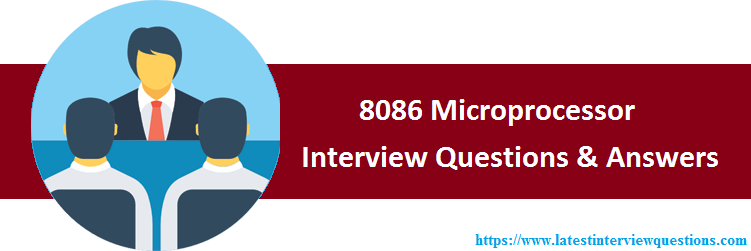8086 Microprocessor Interview Questions & Answers





Best 8086 Microprocessor Interview Questions and Answers
Dear Readers, Welcome to 8086 Microprocessor Interview Questions and Answers have been designed specially to get you acquainted with the nature of questions you may encounter during your Job interview for the subject of 8086 Microprocessor. These 8086 Microprocessor Questions are very important for campus placement test and job interviews. As per my experience good interviewers hardly plan to ask any particular questions during your Job interview and these model questions are asked in the online technical test and interview of many IT & Non IT Industries.
1. What is a Microprocessor?
- Microprocessor is a program-controlled device, which fetches the instructions from memory, decodes and executes the instructions. Most Micro Processor are single- chip devices.

2. Give examples for 8 / 16 / 32 bit Microprocessor?
- 8-bit Processor - 8085 / Z80 / 6800; 16-bit Processor - 8086 / 68000 / Z8000; 32-bit Processor - 80386 / 80486.
3. Why 8085 processor is called an 8 bit processor?
- Because 8085 processor has 8 bit ALU (Arithmetic Logic Review). Similarly 8086 processor has 16 bit ALU.
4. What is 1st / 2nd / 3rd / 4th generation processor?
- The processor made of PMOS / NMOS / HMOS / HCMOS technology is called 1st / 2nd / 3rd / 4th generation processor, and it is made up of 4 / 8 / 16 / 32 bits.
5. Define HCMOS?
- High-density n- type Complimentary Metal Oxide Silicon field effect transistor.
6. What does microprocessor speed depend on?
- The processing speed depends on DATA BUS WIDTH.
7. Is the address bus unidirectional?
- The address bus is unidirectional because the address information is always given by the Micro Processor to address a memory location of an input / output devices.
8. Is the data bus is Bi-directional?
- The data bus is Bi-directional because the same bus is used for transfer of data between Micro Processor and memory or input / output devices in both the direction.
9. What is the disadvantage of microprocessor?
- It has limitations on the size of data. Most Microprocessor does not support floating-point operations.
10. What is the difference between microprocessor and microcontroller?
- In Microprocessor more op-codes, few bit handling instructions. But in Microcontroller: fewer op-codes, more bit handling Instructions, and also it is defined as a device that includes micro processor, memory, & input / output signal lines on a single chip.
11. What is meant by LATCH?
- Latch is a D- type flip-flop used as a temporary storage device controlled by a timing signal, which can store 0 or 1. The primary function of a Latch is data storage. It is used in output devices such as LED, to hold the data for display.
12. Why does microprocessor contain ROM chips?
- Microprocessor contain ROM chip because it contain instructions to execute data.
13. What is the difference between primary & secondary storage device?
- In primary storage device the storage capacity is limited. It has a volatile memory. In secondary storage device the storage capacity is larger. It is a nonvolatile memory. Primary devices are: RAM / ROM. Secondary devices are: Floppy disc / Hard disk.
14. Difference between static and dynamic RAM?
- Static RAM: No refreshing, 6 to 8 MOS transistors are required to form one memory cell, Information stored as voltage level in a flip flop. Dynamic RAM: Refreshed periodically, 3 to 4 transistors are required to form one memory cell, Information is stored as a charge in the gate to substrate capacitance.
15. What is interrupt?
- Interrupt is a signal send by external device to the processor so as to request the processor to perform a particular work.
16. What is cache memory?
- Cache memory is a small high-speed memory. It is used for temporary storage of data & information between the main memory and the CPU (center processing unit). The cache memory is only in RAM.
17. What is called .Scratch pad of computer.?
- Cache Memory is scratch pad of computer.
18. Which transistor is used in each cell of EPROM?
- Floating .gate Avalanche Injection MOS (FAMOS) transistor is used in each cell of EPROM.
19. Differentiate between RAM and ROM?
- RAM: Read / Write memory, High Speed, Volatile Memory. ROM: Read only memory, Low Speed, Non Voliate Memory.
20. What is a compiler?
- Compiler is used to translate the high-level language program into machine code at a time. It doesn.t require special instruction to store in a memory, it stores automatically. The Execution time is less compared to Interpreter.
21. Which processor structure is pipelined?
- All x86 processors have pipelined structure.
22. What is flag?
- Flag is a flip-flop used to store the information about the status of a processor and the status of the instruction executed most recently
23. What is stack?
- Stack is a portion of RAM used for saving the content of Program Counter and general purpose registers.
24. Can ROM be used as stack?
- ROM cannot be used as stack because it is not possible to write to ROM.
25. What is NV-RAM?
- Nonvolatile Read Write Memory, also called Flash memory. It is also know as shadow RAM.